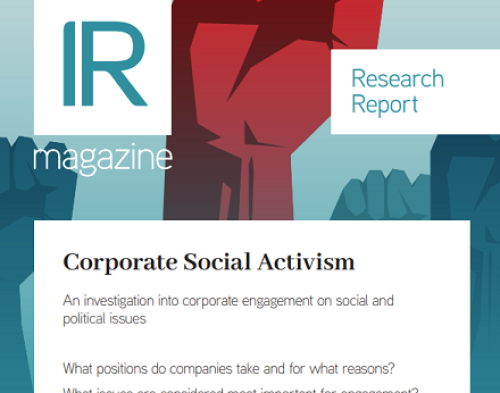Sponsored content
Given investors’ growing focus on ESG issues, public companies need to take a strategic approach to ESG disclosure and engagement. But that’s easier said than done. Companies starting out on their ESG journey are faced with a myriad of choices about how to implement sustainability programs and report on their progress.
To help cut through the clutter, our recent webinar discussed the most effective ways for companies to approach ESG disclosure and engagement, as well as considering the most suitable role for investor relations to play in the process. The panel featured: Karen Greene, investor relations partner at Q4; Katrina Rymill, vice president of IR and sustainability at Equinix; and Chad Spitler, founder and CEO of investor advisory firm Third Economy.
Why ESG matters
Both passive and active investors are increasing their interest in ESG, explained Spitler. ‘Passive managers, which can’t sell securities that are held in the index, have adopted ESG as a fiduciary tool to mitigate risk,’ he said, while active managers have the opportunity to ‘leverage ESG in their buying or selling.’
Greene highlighted that the governance aspect of ESG has been on investors’ radar ‘for years now’. She explained how, at a previous company, she had to contend with a failed say-on-pay vote and lead the response. ‘As the IRO, I really had to shepherd the messages from our investors back to the board and say, Listen, guys, we have a problem here, we really need to pay attention to this,’ she said.
For Rymill, investor interest in ESG has noticeably jumped over the last year. She includes sustainability information in the playbook she sends out to the investment community. ‘I’ve had maybe 10 percent to 20 percent of the investors ask me about it,’ she said, which was ‘definitely not the case last year, so the interest level is picking up.’
Why investor relations
Next, the webinar tackled the part investor relations should play in strategic ESG communications and engagement. Greene said a key role of IR is to help companies understand any changes to the buy side that are taking place, including the growing importance of ESG. In addition, she said investor relations plays a key role in communicating to the market that the company is managing ESG issues well.
But for companies to truly get on top of any issues, they need to adopt a ‘cross-departmental approach’. Referring to her previous role, Greene said: ‘I rang the alarm and said we have to get serious on this. But it took multiple people within my organization to help really pull [the response] together.’
Spitler said the ‘IR role as it relates to ESG’ is not so different from how investor relations deals with ‘business factors that need to be communicated to the investor audience… the IR team is the front door.’ In terms of who should own the sustainability effort, he said companies are adopting a variety of approaches – for example, placing it with the corporate secretary, sustainability officer or investor relations.
‘I think it’s less about who or which department, and more about the substance,’ he said, adding that ‘a good-quality ESG program or strategy really requires breaking down silos and pulling together people from different areas of expertise who wouldn’t normally engage throughout their day-to-day work.’
Rymill is an example of someone who owns both investor relations and sustainability at her company. She said it ‘makes a tremendous amount of sense for IROs to expand our role into the sustainability side, given the importance to ESG of messaging, communication and connecting departments across the organization. I see many different IROs looking at expanding into this area.’
ESG engagement
Later in the webinar, the conversation turned to best practices for ESG engagement. Spitler encouraged companies to think about the year in two parts: away from proxy season, focus on relationship building; during proxy season, focus on securing approval for your resolutions. He noted that, if companies are not hearing back from investors, that could be a positive. ‘It could mean they don’t have any questions or concerns and they’re focused on other companies,’ he said.
Greene discussed how her previous company responded to its failed say-on-pay vote. ‘During the month prior to proxy season, we made a point of getting in front of the compliance teams at some of our top investors, both active and passive,’ she said. One of the main issues for her company was that a proxy adviser had placed it in an inappropriate peer group. ‘We made a point of going to meet with compliance teams and walking them through our logic of who our peer group should be,’ she explained.
Greene took the head of the compensation committee and the lead independent director with her to meetings. ‘It’s very important to bring along the right part of the organization,’ she explained. Her company made a habit of conducting annual governance roadshows and it’s something she said she ‘highly recommends to our clients, which are now grappling with all these components, not just governance.’
ESG reporting and communications
A tricky issue for companies when developing their ESG communications is determining which of the various reporting frameworks to focus on. Spitler said the two most common are those of the Global Reporting Initiative, which has been around longer and has a stakeholder focus, and the Sustainability Accounting Standards Board, which is concerned with materiality and has a sector-specific approach.
Spitler said there are two other emerging reporting practices: ‘One is alignment with the [UN’s] Sustainable Development Goals, so we’re seeing a lot of sustainability reports now incorporating those. And of course, the Task Force on Climate-related Financial Disclosures (TCFD) has rapidly come on to the scene.’ The TCFD is particularly important for heavy-emitting industries and financial firms that provide capital to those industries, he added.
Greene reminded the audience that it’s the ‘substance behind what you’re communicating that is probably the most important component to tackle first.’ Once that is in place, she said ‘having an ESG page on your website is extremely important to help communicate the company’s policies.’ She noted that sustainability information should be found across ‘all the company’s reporting’, such as regulatory filings, the investor deck and, if it makes sense, a stand-alone report.
Companies should also think of ESG engagement as more than a one-off event, Greene added: ‘It’s a journey. It’s not like a project that has a beginning, a middle and an end.’
Turning to the topic of ratings agencies, Rymill said not disclosing information on a particular area can lead to companies being marked down quite severely. ‘The reality is you get zero out of 100 when you don’t disclose it,’ she said. ‘So, for example, on RobecoSAM right now, we’re getting hit because we don’t have any policies on human rights.’
Advice for getting started
Throughout the webinar, a common topic of conversation was where to start with an ESG program, given that the multitude of options can feel overwhelming. Rymill offered the following tips:
– First of all, you need to understand what your sustainability programs actually are. ‘The first [step] is just understanding the programs and then you can figure out: what do you want to report on? What’s your strategy around that? How do you want to push the team to do more?’ she said.
– The second part is working out your messaging, reporting and CSR reports, and then figuring out ‘how you communicate that to your customers, your media and your investors.’
– The third part is risk. Rymill said companies need to think about how they disclose around ESG risks, particularly climate change. ‘Has anyone in your company done the analysis [for if temperatures go up two degrees]?’ she asked. ‘I’m just starting to look into this, but I think it’ll get more and more interest as we go along.’
Greene, meanwhile, pointed out that ESG engagement is something all companies – whatever their size – need to start thinking about. ‘I don’t think there’s a distinction here,’ she said. ‘Obviously large caps are better positioned to throw more bodies at this. But I was a small cap fighting this failed say-on-pay issue – in fact, I was a micro-cap. So I don’t think small caps are exempt from this issue in any way. I think it’s just as important [for them].’
To learn more about building an effective ESG plan, we recommend watching the full webinar recording or checking out our blog post: Three highly effective ways to showcase ESG on your IR site.










